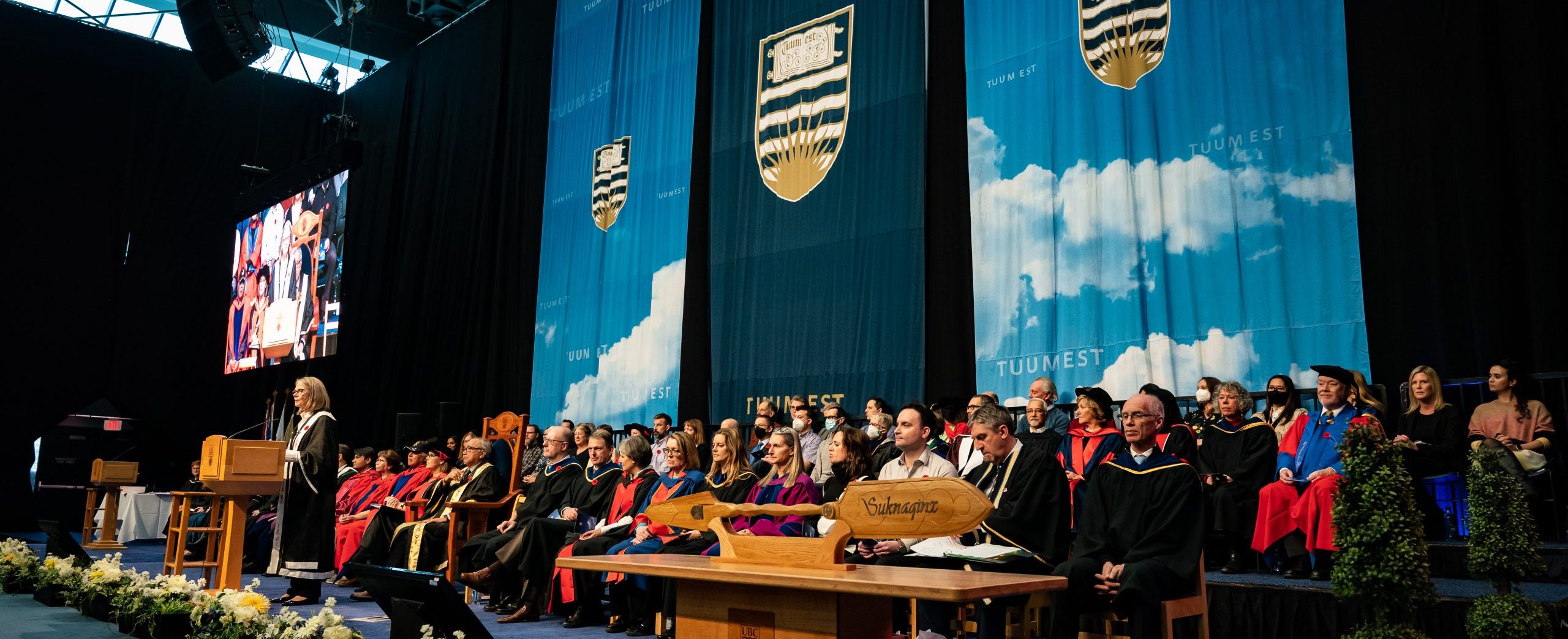Graduation is a long-standing tradition that students of all fields of study look forward to upon completion of their chosen academic program. UBC is proud to honour the roots of this tradition by outlining UBC’s convocation history below.

Looking back
- UBC’s first convocation ceremony took place on May 4, 1916 in the Hotel Vancouver ballroom. There were 41 graduates.
- UBC’s first convocation ceremony at UBC Okanagan took place on June 9, 2006.
- Student’s from UBC’s Vancouver campus now graduate from 12 faculties: Agricultural Sciences, Applied Science, Arts, Commerce and Business Administration, Dentistry, Education, Forestry, Graduate Studies, Law, Medicine, Pharmaceutical Sciences and Science.
- Each year since 1919, the graduating class has planted a tree to mark convocation.
- The first convocation ceremony on the present day campus was held in 1927.
- The University Mace is a symbol of the authority of the Chancellor. It is displayed on ceremonial occasions, most notably during the convocation ceremonies, but also during the Installation of a President or Chancellor.
- When graduating students are presented to the chancellor he or she says “I admit you,” welcoming them to convocation, the body of graduates that elects the chancellor and some university senators.
- Hoods and gowns worn by graduates are lined with colours that indicate the degree to be conferred (see Academic Regalia). Members of the convocation processions wear colourful academic regalia from around the world signifying their university of graduation and highest degree awarded.
- The gowns, hoods and mortarboards worn by graduating students evolved from clothes worn by European scholars in the Middle Ages.
UBC’s graduation journey
The UBC graduation journey has been forged by the spirit of the university’s motto, Tuum Est, (meaning “it is yours”) since 1915. Today, graduating classes continue to shape UBC’s history by making it their own.

1916
One of the first graduating classes was the Arts Class of 1916, pictured here at a party at the home of Mary Wilons. In UBC’s first year, there were only three faculties: Arts, Applied Science and Agriculture, with 379 registered students and 34 faculty members.

1920s
The twenties saw the student-led Great Trek to UBC’s new Point Grey campus, establishing the university as a place where students could help shape a better world. The AMS incorporated as a non-profit society and the university began awarding its first graduate degrees to students. In the Ubyssey, published in September 23, 1925, students described the new campus with a sense of wonder: “We are dazed with the appearance of architectural cleanliness and bewildered by our lineal freedom.”

1940s
The forties were an era of tremendous change at the university as both students and faculty embraced the war effort. In 1943, new President Norman MacKenzie began in earnest to expand the university, and new departments were formed along with new buildings to house them. These included Brock Hall, the first student union building. By the 1950s, UBC had established itself as a comprehensive university and top choice for students in BC and beyond.

1960s
Student numbers continued to escalate alongside the scholarly activities that began to define UBC as a leader in research. The campus was alive with sixties counterculture, and a sixth president of UBC was elected by the name of Dr. Walter Gage. New student residences were created to respond to the expanding student body, as well as a new student union building. Students gained influence at the university and were elected to the University Board of Governors for the first time.

1980s
With over 34,000 students registered at the beginning of the eighties, UBC began attracting scholars from all over the world. Engineering students were in the news frequently for their pranks, which included the famous Ladner Clock Tower stunt, in which students pulled off hoisting a white Volkswagen Bug onto the top of the tower. Dr. Martha Piper was elected President in 1997 and ushered in an era of international engagement that saw UBC step onto the world stage as an educator and global centre for research excellence.

2000s
UBC’s Okanagan campus was established in 2005 and in September of that year, 3,500 students started classes at the new institution alongside an opening ceremony celebrating the occasion. UBC’s welcome in Syilx Okanagan territory was formalized with the signing of a Memorandum of Understanding which pledged to build long-term, collaborative relations.

2025
Celebrating 20 years in 2025, UBC Okanagan continues to build a transformative university experience forged from bold ideas and shaped by meaningful partnerships. Groundbreaking research, learning through experience, and a deep sense of place define the campus’s past and future. This year’s graduates join 20 years of alumni who are transforming communities here in the Okanagan and beyond.